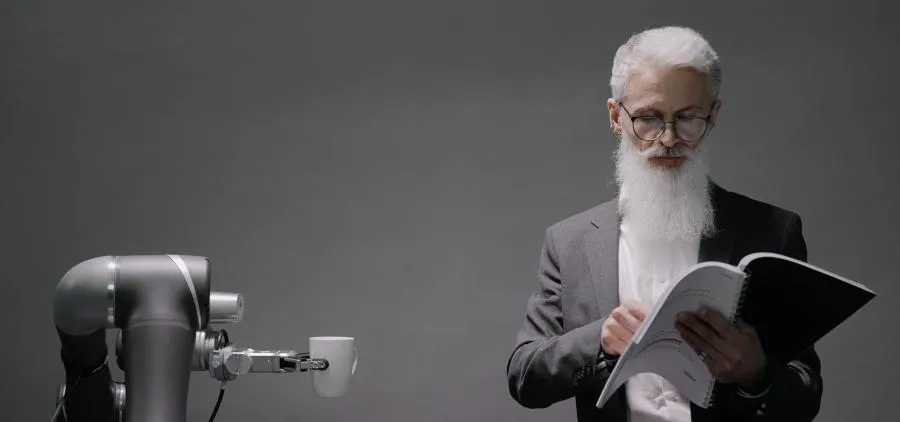
Artificial Intelligence and the Future of Work — A Professional Survival Guide
Inspired by two podcasts on AI and the future of work.
Artificial intelligence is no longer just a support tool. Today, there are agents capable of browsing the web, generating audiovisual content, and executing complex tasks without human supervision.
This shift not only transforms industries: it redefines which tasks remain human, which roles will disappear, and how we must prepare to stay relevant.
Will AI eliminate all jobs?
Yes, but not in the way you think.
AI will completely transform the job market: it will destroy some jobs, change many, and create new ones.
This post is a navigation map for those who don’t want to be left behind.
1. Anything repeatable will be automated
Operational and predictable tasks (like support, data entry, or basic coordination) are being absorbed by autonomous agents.
In many startups, this is already evident: companies are scaling without hiring, thanks to automation.
But automating doesn’t mean losing jobs, it means redirecting human effort to what AI still can’t do.
📝 Suggestions
Identify repetitive tasks and consider delegating them to AI tools.
Don’t hide your automations: use them to demonstrate improvements in quality or speed.
Focus on higher-value tasks: strategy, creativity, design, relationships.
2. Knowing how to do is not enough: knowing how to integrate matters
Today’s critical skill isn’t just execution, it’s the ability to combine human judgment with automated tools.
Just like the mechanical loom (automation), the slide rule (speed), or the crane (capacity) in their time, AI is a lever: it delegates, accelerates, and amplifies how work gets done.
📝 Suggestions
Learn to use an AI tool aligned with your work or industry.
Design small hybrid workflows between human + AI.
Practice critical review: it’s not just about using AI, but enhancing it with your judgment.
3. Automating isn’t betraying your role: it’s redesigning it
People once thought Excel would eliminate accountants. The opposite happened: their role became more sophisticated.
The same could happen with designers, marketers, writers, or project managers.
What gets replaced is not the person, but the old way of doing things.
📝 Suggestions
Identify tasks that don’t require human judgment. Automate them.
Redefine your contribution: what part of your work is uniquely human?
Show how automation doesn’t reduce value, it multiplies it.
4. Change isn’t linear: it’s cyclical and accelerated
The job market shifts every 2 to 3 years. In this new pace, being adaptable is safer than specializing too early.
AI enables no-code software creation, content generation without cameras or editors, problem-solving without large teams. The talent of the future will learn, integrate, and reconnect knowledge based on context.
📝 Suggestions
Every quarter, try a new tool or technique.
Maintain a side project as a space for testing and learning.
Anticipate change: waiting is no longer an option.
5. Creating is safer than just executing
AI still can’t propose directions, spot opportunities, or create meaning.
Humans will continue working (even with universal basic income) for deeper reasons: status, purpose, connection, curiosity.
📝 Suggestions
Pitch ideas even if no one asks. Iterate. Test.
Document what you learn and share it: teaching is the new positioning.
Create your “experiment portfolio”: a newsletter, channel, app, course, or community.
6. Your attention, identity, and judgment matter more than ever
In an environment full of deepfakes and AI-generated content, the real value lies in filtering, interpreting, and deciding.
More than ever, protecting your attention and focus becomes a strategic decision.
📝 Suggestions
Enable verification, use password managers, and protect your digital identity.
Define real focus blocks. Avoid extreme multitasking.
Use AI as a curator, not as a content overload machine.
7. Adapting alone isn’t enough
AI can do many things, but it can’t replace a creative, trustworthy, and collaborative human network. Real relationships are your most valuable professional capital.
📝 Suggestions
Invest time in non-transactional relationships.
Join real conversation spaces (circles, coworking spaces, communities).
Collaborate even if it’s not immediately profitable: it’s adaptability training.
How to Start — 100 Practical Use Cases for ChatGPT
Talking about adapting is good, but applying it is even better.
That’s why we’re closing this guide with a curated list of 100 concrete ways to use ChatGPT in your work, projects, or daily life.
From personal productivity to business, content creation, technical analysis, and collaboration:
🧠 Productivity & Personal Organization
Daily planner for tasks and schedules
Weekly/monthly goal tracking
Email drafts from rough ideas
Meeting summaries with key actions
Personalized travel itineraries
Weekly meal planning with shopping list
Habit-building or breaking strategies
Budgeting and financial organization tips
Language practice through simulated dialogues
Personal style assistant for outfits
✍️ Creativity & Content Generation
Blog article outlines
Social media titles and descriptions
Persuasive ad copy
Brainstorming stories, characters, plots
Poetry or song lyrics in different styles
Scripts for YouTube or TikTok videos
Newsletter content
Podcast episode notes
Visual descriptions for designers or image AIs
Presentation and pitch deck structures
📈 Business & Marketing
Market and trend analysis
Ideal customer profile creation
SEO keyword lists
Press release writing
Sales email sequences
Advertising campaign strategies
Product or brand name ideas
Brand voice and tone guides
SWOT analysis of businesses or projects
Client success story writing
💻 Tech Support & Programming
Code snippet generation
Help with debugging
Guide to integrating popular APIs
Complex algorithm explanation in simple terms
Unit test templates
DevOps automation scripts
SQL or pandas queries for data processing
Technical architecture diagrams
Tech stack recommendations
Cybersecurity best practices
📚 Education & Learning
Academic topic explanations by level
Quiz or exercise generation
Step-by-step problem solving
Foreign language text correction
Flashcards for memorization
Essay or assignment outlines
Step-by-step programming tutoring
Historical timelines
Lab report templates
Speaker notes for presentations
🔍 Research & Analysis
Academic paper summaries
Data or chart interpretation
Source or bibliography suggestions
Effective survey design
Research hypothesis generation
Competitor mapping in a sector
Project risk evaluation
Public policy summaries
Funding proposal drafts
Statistical method recommendations
🛎️ Customer Support & Operations
FAQ creation
Ticket response writing
Chatbot scripts
Onboarding manuals for users or employees
Internal process documentation
KPI dashboard ideas
Inventory optimization tips
Supplier selection criteria
Incident report templates
SLA (Service Level Agreement) templates
🌱 Health, Wellness & Lifestyle
Personalized workout routines
Guided meditation scripts
Nutritional analysis of meals
Sleep improvement tips
Journaling and mental health prompts
DIY or repair project guides
Gardening plans by climate and space
Event or celebration checklists
Recipe adaptations for dietary restrictions
Pet care and training tips
🔬 Specialized & Emerging
Legal document drafts (for review later)
Medical article summaries (non-clinical)
Basic financial models
Real estate investment evaluation
UX interview or user testing scripts
Web accessibility audits
Commands for robots or simulators
Biomedical educational material
AI ethics principles
Goal-setting for autonomous agents (Auto-GPT)
🤝 Collaboration & Teamwork
Brainstorming workshop guides
Retrospective meeting agendas
Simulated tough client conversations
Conflict resolution language
Team-building activities
Effective intercultural communication
RACI matrices and governance frameworks
Innovation or product development roadmaps
Stakeholder update drafts
Internal wiki or knowledge base articles
Conclusion
AI has already changed the rules of the game.
It’s not about resisting change, it’s about learning to move with it.
Those who experiment, adapt, and take initiative will have more opportunities than ever.

